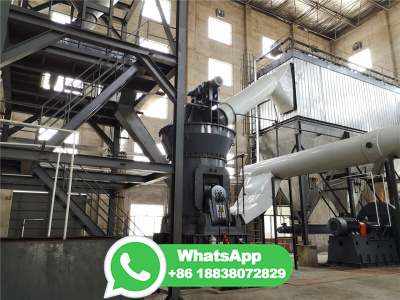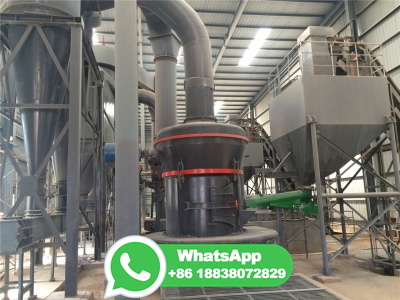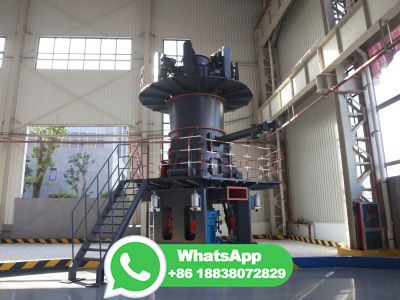
It is established in ball milling, the particle size distribution curve of the product is generally parallel to the feed size (Bond, 1961). In HPGR, size reduction is
WhatsApp: +86 18037808511
Modeling is based on the characterization of the grinding products obtained after various grinding periods and the description of the particle size distributions using mathematical approaches,, GatesGaudinSchuhmann (GGS), RosinRammler (RR), and logistic distributions.
WhatsApp: +86 18037808511
A particle size distribution indicates the percentage of particles of a certain size (or in a certain size interval). These intervals are also called size classes or fractions. A simple example is shown below. Here, a mixture of grinding balls has been separated by size: 5 mm, 10 mm, 15 mm and 40 mm: 5 mm. 10 mm. 15 mm.
WhatsApp: +86 18037808511
Table 21 factors and levels were combined in a homogeneous design with a total of five influencing factors in the experiment: X1 — ball mill rotation rate, X2 — aluminum powder particle size, X3 — aluminum mass, X4 — steel sand mass, and X5 — steel sand particle size. According to the principle of uniform design, the number of trials should be the least common multiple of the number ...
WhatsApp: +86 18037808511
Particle Size Distribution of Different Grinding Systems Free download as PDF File (.pdf), Text File (.txt) or read online for free. Particle size distributions for different ores and grinding systems have been studied with measurements down to ca 2 μm. When mineral aggregates are ground, two maxima are normally observed in the mass frequency curve for the ground product, a coarse grinding ...
WhatsApp: +86 18037808511
According to Suha Ozsoylu, director of operations at Hosokawa Micron Powder Systems, the most important step in selecting size reduction equipment is establishing the target size reduction of the end product. This target is typically based on the particle size and particle size distribution desired, typically expressed in terms of milling ...
WhatsApp: +86 18037808511
paints might be ground in the medium in which they are to be suspended. Wet grinding often takes place in ball, pebble or rod mills. The efficiency of wet grinding can be higher than that for dry grinding, but wear of equipment is also higher. Usually, some form of separation follows size reduction. The most common is simple screening, in
WhatsApp: +86 18037808511
The purpose of the primary crusher is to reduce the ROM ore to a size amenable for feeding the secondary crusher or the SAG mill grinding circuit. The ratio of reduction through a primary crusher can be up to about 8:1. Feed: ROM up to m. Product: 300mm (for transport) to 200mm (for SAG mill) Feed Rate:
WhatsApp: +86 18037808511
Grinding Studies. Two kinds of mills, BBM and LBM, were used to achieve the desired P 80 passing percentage of 150 μm with an acceptable range of hematite liberation (> 75%) at optimum grinding time. The BBM is a standard ball mill having a length and diameter of 300 mm × 300 mm with smooth liner as shown in Fig. rotating drum is attached to a gearbox and has adjustable speed knob.
WhatsApp: +86 18037808511
In this paper, we carried out batch grinding tests of silica glass, limestone and gypsum with a ball mill and investigated the effects of feed size and ball diameter on the grinding rate constant (selection function). The results are summarized as follows; 1. Variation of the dimensionless grinding rate constant with feed size was roughly ...
WhatsApp: +86 18037808511
Among the different mathematical models used to simulate the particle size distribution, RosinRammler (RR) was found to be the most suitable. ... Simple regression analysis with the use of Excel software was carried out to establish potential ... ; Sharma, S. Analysis of ball mill grinding operation using mill power specific kinetic ...
WhatsApp: +86 18037808511
He concluded that the size distribution from a laboratory rod mill gave a similarshaped size distribution to that of a closed circuit laboratory ball mill. He also demonstrated how a laboratory rod mill gave a similar shape of size distribution to a 36 inch ( m) Hardinge ball mill in closed circuit with a rake classifi er treating the same ore.
WhatsApp: +86 18037808511
The complete SABC process includes sem iautogenous grinding, ball . milling, and pebble crushing. ... particle size distribution, mill power, and other parameters are studied.
WhatsApp: +86 18037808511
The measured particle size distribution was modeled using a Gaudin Schuman model. An online linear regression algorithm was used to estimate the particle size parameter (k) and the particle size distribution shape modulus (a). This modulus has been found very useful in managing the particle size feed to the SAG mill by manipulating the percent ...
WhatsApp: +86 18037808511
Section snippets Materials and methods. Three master alloys were produced by a proprietary technique (M1, M2 and M3). They were then ground using a laboratory ballmill (Zoz Simoloyer CM012 L). 3 kg of steel balls (ϕ = mm, 60 HRC), as the grinding media, occupied L of the 2 L ball/powder ratio of ~ 10/1 (weight), a rotational speed of 1000 RPM and a constant flow of argon ...
WhatsApp: +86 18037808511
The typical particle size for a ball mill item would be between 300 and 500 mm, with a less than 20 mm product size . The feed slurry contains between 30 and 60% solids. Stirrers in stirred mills typically rotate at high speeds, around 25 m/s, with high energy densities. ... For the same size distribution, dry grinding requires 1550% greater ...
WhatsApp: +86 18037808511
target particle size, or changes in grain moisture calls for particle size evaluation using the 13sieve method. Additionally, any adjustments made to the mill with roll parallel, screens, or hammers; particle size should be retested with the 13sieve method. Sampling to test particle size should be after the rolls or hammers where there is a ...
WhatsApp: +86 18037808511
The feed samples of X, Y, and Z iron ores were ground in the BBM (ball mill refers to a BBM of size 300 mm × 300 mm with smooth liners) to identify the PSD, BWI, and RT of each ore. Grinding experiments were conducted according to Bond's standard test procedure [].For each iron ore sample, the RT taken to produce 250% circulating load in the BBM was measured by a new method.
WhatsApp: +86 18037808511
The performance of various diameter ball mills can now be simulated using the following mechanisms: (1) an orespecific breakage distribution function determined from pendulum tests (the results are given in Table III); (2) a breakagerateparticlesize relationship for a given ball mill diameter obtained from the known constant relationship ...
WhatsApp: +86 18037808511
A comprehensive investigation was conducted to delineate the effect of ball size distribution, mill speed, and their interactions on power draw, charge motion, and balls segregation in a laboratoryscale mill. The mill was simulated at different critical speeds with different mill fillings. In total, 165 scenarios were simulated.
WhatsApp: +86 18037808511
Sampling of material. Take ~1 kg sample every 1 m along mill axis. Each sample collected from 3 point in the same cross section. Removed some balls and taken sample. First and last sample in each compartment should be taken. from m off the wall or diaphragms. 4. Sampling inside mill (mill test) cont.
WhatsApp: +86 18037808511
Based on his work, this formula can be derived for ball diameter sizing and selection: Dm <= 6 (log dk) * d^ where D m = the diameter of the singlesized balls in = the diameter of the largest chunks of ore in the mill feed in mm.
WhatsApp: +86 18037808511
The ball size of cm shows slight changes in particle median diameter over time, while cm ball size requires more grinding time to reduce metallurgical coke particles. Six different particle size distribution (GatesGaudinSchuhmann (GGS), RosinRammler (RR), Lognormal, Normal, Gamma, and Swebrec) models were compared under ...
WhatsApp: +86 18037808511
In this research, ball size distribution which is a function of makeup ball sizes was investigated to optimise the milling stage of a grinding circuit in order to maximise the production of the narrowlysized mill product for floatation, in this case − 75 + 9 μ m. Section snippets
WhatsApp: +86 18037808511
mill speed (% of Nc), ball filling ratio (J), ball size distribution (%), powder filling ratio (fc), grinding aid dosage (g/Mg) and grinding time (min) on the dry fine grinding of calcite using a laboratory batch scale conventional ball mill. The evaluation of the results of grinding tests was performed based on the product particle size (d 50 ...
WhatsApp: +86 18037808511
1. Introduction A mix of balls of different diameters enables the effective milling of different particle sizes in a tumbling mill while ensuring the optimisation of the mill product. This is owing to the fact that each ball size effectively breaks a particular size in the mill [1], [2].
WhatsApp: +86 18037808511
To download Holcim Process Guide and all other Useful Books and calculations Excel sheets please click here BALL CHARGE DESIGN you will have to fill the cells which are highlighted in yellow and the results will appear in Red Ball charge management Top up for ball wear compensation.
WhatsApp: +86 18037808511
The apparent difference in capacities between grinding mills (listed as being the same size) is due to the fact that there is no uniform method of designating the size of a mill, for example: a 5′ x 5′ Ball Mill has a working diameter of 5′ inside the liners and has 20 per cent more capacity than all other ball mills designated as 5′ x ...
WhatsApp: +86 18037808511